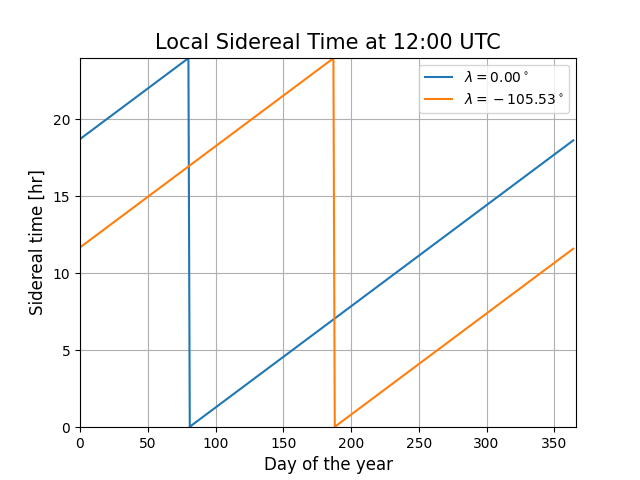Note
Go to the end to download the full example code.
Local Sidereal Time#
Studying the yearly variations in sidereal time
import matplotlib.pyplot as plt
import numpy as np
import mirage as mr
import mirage.vis as mrv
stations = [mr.Station(lon_deg=0.0), mr.Station(preset='pogs')]
dates, epsecs = mr.date_arange(
mr.utc(2020, 1, 1, 12),
mr.utc(2020, 1, 1, 12) + mr.years(1),
mr.days(1),
return_epsecs=True,
)
We can see that as expected, Greenwich passes LST = 0 at noon on the vernal equinox (~80 days into the year). Rephrased, this means that at noon on the vernal equinox, the local meridian at Greenwich is pointing in the direction of inertial \(\\hat{x}\), the first point of Aires, zero right ascension. On the same date, the station in New Mexico is always facing 105 degrees earlier.
for station in stations:
sid_time = np.rad2deg(mr.sidereal_hour_angle(station.lon_rad, dates)) / 360 * 24
plt.plot(epsecs / mr.AstroConstants.earth_sec_in_day, sid_time)
mrv.texit(
'Local Sidereal Time at 12:00 UTC',
'Day of the year',
'Sidereal time [hr]',
[f'$\lambda = {s.lon_deg:.2f}^\circ$' for s in stations],
)
plt.ylim(0, 24)
plt.xlim(0, 366)
plt.show()

/Users/liamrobinson/Documents/maintained-research/mirage/examples/07-observer/local_sidereal_time.py:32: SyntaxWarning: invalid escape sequence '\l'
[f'$\lambda = {s.lon_deg:.2f}^\circ$' for s in stations],
/Users/liamrobinson/Documents/maintained-research/mirage/examples/07-observer/local_sidereal_time.py:32: SyntaxWarning: invalid escape sequence '\c'
[f'$\lambda = {s.lon_deg:.2f}^\circ$' for s in stations],
For example, on June 2nd (day 153 of the year), the LST at 12:00 UTC is approximately 21.67/24 * 360 = 325 degrees. For an observation at ~6:00 UTC, we subtract another 6/24*360 degrees to yield LST = 235 degrees.
Total running time of the script: (0 minutes 0.162 seconds)
